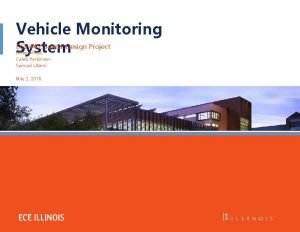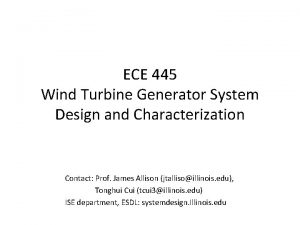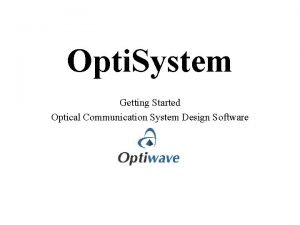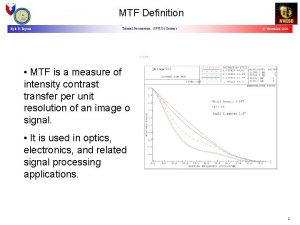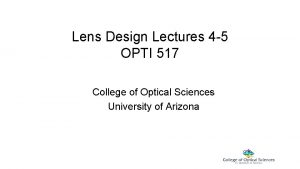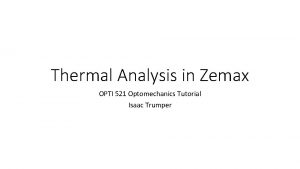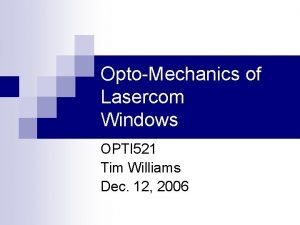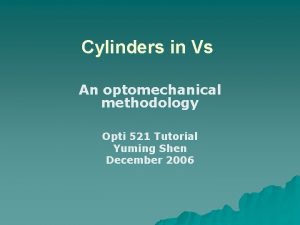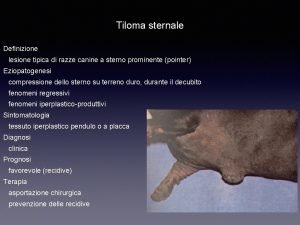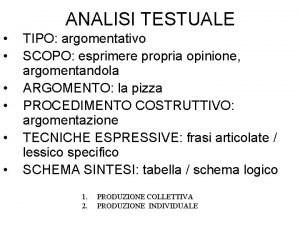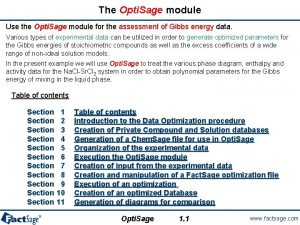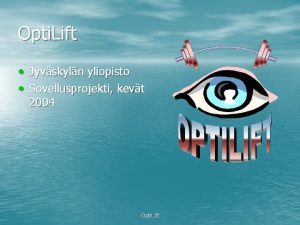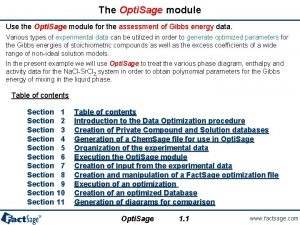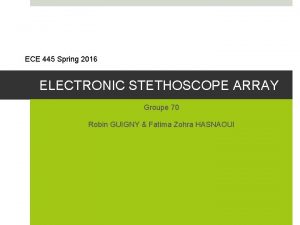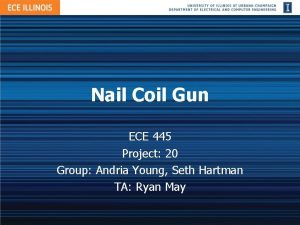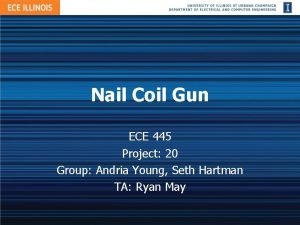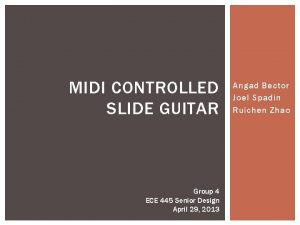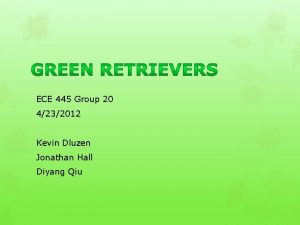Opti Cane Group 18 ECE 445 Spring 2019

![Introduction ● 36 million people are blind worldwide[1] ● Current solutions include: volunteer guides, Introduction ● 36 million people are blind worldwide[1] ● Current solutions include: volunteer guides,](https://slidetodoc.com/presentation_image_h2/099916aa5ca5458ea38d906c0ef1d2a8/image-2.jpg)






















![References [1] World Health Organization, ‘Blindness and vision impairment’, 2018. [Online]. Available: https: //www. References [1] World Health Organization, ‘Blindness and vision impairment’, 2018. [Online]. Available: https: //www.](https://slidetodoc.com/presentation_image_h2/099916aa5ca5458ea38d906c0ef1d2a8/image-25.jpg)
- Slides: 25

Opti. Cane Group 18 ECE 445 Spring 2019 Angela Park Christian Reyes Yu Xiao Zhang
![Introduction 36 million people are blind worldwide1 Current solutions include volunteer guides Introduction ● 36 million people are blind worldwide[1] ● Current solutions include: volunteer guides,](https://slidetodoc.com/presentation_image_h2/099916aa5ca5458ea38d906c0ef1d2a8/image-2.jpg)
Introduction ● 36 million people are blind worldwide[1] ● Current solutions include: volunteer guides, service dogs, white canes ● White canes provide independence at relatively low costs

Objective ● Use sensor array for object detection in urban environments ● Create haptic feedback in the form of vibration patterns and differing intensity

Design

Physical Layout ● Sensors spaced 13 inches along the stick ● Stick must be held by user at 45° angle to align sensors parallel to ground

Physical Layout ● Robust design while maintaining lightweight factor ● Aluminum construction ● Rigid yet flexible to withstand tapping and bumping

Hardware Overview ● ● Power Supply- 9 V Li-Ion Battery Control Unit - Microcontroller Sensor Module Feedback Module

Block Diagram

Power Supply ● 9 V Li-Ion Battery housed in PCB housing ● Removable ● 5 V, 3. 3 V, and 2. 8 V voltage regulators

Total Current Draw Device Quantity Current Laser sensor (active ranging mode) 4 76 m. A Haptic Motor Driver (average battery current during operation) 1 2. 5 m. A Motor Disc (maximum rated current) 1 60 m. A Microcontroller (16 MHz at 5 V) 1 10 m. A Total 148. 5 m. A

Power Supply (Results) ● Starting voltage: 9. 69 V ● Ending voltage: 8. 57 V (after 3 hours)

Control Unit ● ATmega 328 p ● 16 MHz clock, 5 V operating voltage

Laser Sensor Module ● VL 53 L 0 X Time-of-Flight Laser Sensor ● Detection range: 30 mm - 2. 2 m

Laser Sensor Array (Results) - Plot

Laser Sensor Array (Results) Analysis ● Percent error calculation ● Average percent error ○ 2. 017%

Feedback Module ● DRV 2605 L motor driver ● Provides tactile information from sensor array

Haptic Feedback (Results)

Software Overview Sensor Number Starting from Bottom of Cane to Top Vibration Pattern 1 st sensor (bottom) A single vibration separated by a pause. 2 nd sensor Two vibrations in quick succession separated by a pause. 3 rd sensor Three vibrations in quick succession separated by a pause. 4 th sensor (top) Four vibrations in quick succession separated by a pause.

Software Flowchart

Future Hardware Development ● Incorporate battery gauge ● Battery rechargeability ● Gravity sensors, such as gyroscope or accelerometer, for orientation ● Molded handle for user to hold at correct orientation

Future Software Development ● Unique stairs discrimination ● Battery life monitor ● Variable detection range

Ethics and Safety ● Guide users around obstacles through a safe path ● Will not purposefully guide users through dangerous environments ● Will not fabricate false information ● Shall not be used as a weapon ● Violating will infringe upon IEEE code of ethics[2]

Conclusion ● Sensor detection range tested and verified ● Sensors successfully integrated with vibration motor feedback through I 2 C communication

Questions?
![References 1 World Health Organization Blindness and vision impairment 2018 Online Available https www References [1] World Health Organization, ‘Blindness and vision impairment’, 2018. [Online]. Available: https: //www.](https://slidetodoc.com/presentation_image_h2/099916aa5ca5458ea38d906c0ef1d2a8/image-25.jpg)
References [1] World Health Organization, ‘Blindness and vision impairment’, 2018. [Online]. Available: https: //www. who. int/news-room/factsheets/detail/blindness-and-visual-impairment. [Accessed: 3 -February-2019]. [2] Institute of Electrical and Electronics Engineers, Inc, “IEEE Code of Ethics”, 2006, Available: https: //www. ieee. org/about/corporate/governance/p 78. html
 Ece 313 uiuc
Ece 313 uiuc Uiuc cs 445
Uiuc cs 445 Vehicle monitoring system project
Vehicle monitoring system project Ece 445
Ece 445 Ece 445
Ece 445 Opti
Opti Opti
Opti Opti
Opti Mtf tutorial
Mtf tutorial Opti 517
Opti 517 Opti 521
Opti 521 Go opti benetke
Go opti benetke Opti 502
Opti 502 Opti tim
Opti tim Uli finckh
Uli finckh Optisystem tutorial
Optisystem tutorial Cast of spring, summer, fall, winter... and spring
Cast of spring, summer, fall, winter... and spring Spring winter summer fall
Spring winter summer fall Dotto onfalomesenterico
Dotto onfalomesenterico Cane pruning
Cane pruning Decubito a cane di fucile
Decubito a cane di fucile Cane syrup deashing
Cane syrup deashing Descrizione pastore tedesco scuola primaria
Descrizione pastore tedesco scuola primaria Verbi in forma attiva
Verbi in forma attiva Preghiera per il mio cane
Preghiera per il mio cane Testo descrittivo la pizza
Testo descrittivo la pizza


